 John Cage
John Cage(September 5, 1912 - August 12, 1992) revolutionized music as much as anyone in the 20th century. His first important music was for percussion ensembles, utilizing both homemade and ethnic instruments as well as "found objects." He achieved a breakthrough when he moved this style of composition onto the piano by placing objects between the strings to alter the sound and achieve a more percussive effect. This "prepared piano" style caught the attention of avant-garde tastemakers, and he moved to New York, where his music shocked mainstream audiences and critics.
Cage's study of Buddhism led him to believe that meditative tranquility should be the goal of his music. Since he came to feel that music dictated by taste and subjectivity conflicted with tranquility, in 1951 he started creating pieces with chance operations, using the Chinese oracle I Ching (Book of Changes) and incorporating star maps, spots on paper sheets, etc. Sometimes the musicians decided some matters in performance, while in other works everything from the type of attack to durations and dynamics was written out.
This "aleatoric" approach was Cage's most influential innovation, and in 1952 produced 4'33", a three-section piece (the length of the sections determined by chance operations) in which the pianist doesn't actually play any notes, theoretically leading the audience to experience ambient noise as music. After a brief period of "tape music" (pre-synthesizer electronic music -- his 1952 "Williams Mix" was the first piece composed for electronic tape in the U.S.) and a phase of pieces consisting of a sentence instructing the performer to, for instance, write with pen and paper for a microphone for a specified period of time, he returned to notated music, retaining the time-determined structures by giving the performers their notes and a period of time to play them in but not dictating the rhythm ("time bracket" pieces).
Of my album choices, 1-2 belong in the collections of all music lovers, and 3-9 are pretty much must-haves for anyone interested in Cage. The Wergo and Hat Art CDs are imports, not necessarily easy to track down but well worth the effort. mode is doing a complete edition of John Cage's works, an admirable goal. Fortunately, more of my suggested albums have become available on iTunes since I first wrote this article five years ago, and I suspect that all the Wergo and mode albums might be there but just hard to pinpoint in the iTunes search. And, frankly, any mode performance can be substituted for those on Hat Art in terms of quality, since interpretation isn't much of a factor in Cage performance -- I just prefer Hat Art's programs.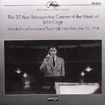
1. The 25-Year Retrospective Concert of the Music of John Cage [Concert for Piano and Orchestra; 6 Short Inventions for 7 Instruments; First Construction in Metal; Imaginary Landscape No. 1; The Wonderful Widow of Eighteen Springs; She Is Asleep; Sonatas and Interludes (first half); Music for Carillon No. 1; Williams Mix]: Manhattan Percussion Ensemble, John Cage, Arline Carmen, Maro Ajemian, David Tudor, etc. (Wergo WER 6247)
This three-disc 1958 concert provides a superb cross-section of Cage's work up to that time and includes Cage as a performer. Two premieres were controversial highlights: the New York premiere of "Williams Mix" drew some boos for its drastic redefinition of music, and Concert for Piano and Orchestra, in its world premiere with the redoubtable Tudor playing piano, provoked an even more negative reaction to its then-shocking extended techniques and microtonality. Six Short Inventions for Seven Instruments, from 1934, uses Serial-related technique. From Cage's percussion period, First Construction in Metal (1939) is for orchestral bells, "thundersheets," prepared piano, 12-gong gamelan, cowbells, Japanese temple gongs, brake drums, anvils, cymbals, muted gongs, water gong, suspended gong, and tam-tam. Imaginary Landscape No. 1 (1942) legendarily foreshadows tape music by using audio research records of constant and variable frequencies, cymbal, and playing inside the piano. "The Wonderful Widow of 18 Springs" adapts text from Finnegan's Wake; the pianist plays percussively on the piano's body. She Is Asleep (1943) combines the Quartet for 12 Tom-Toms and Duo, a vocalise with prepared piano accompaniment. The first half of the Sonatas and Interludes for prepared piano (1946-48) are performed by dedicatee Ajemian. Tudor uses a two-octave electronic carillon for Music for Carillon No. 1 (1952).
2. Sonatas & Interludes for prepared piano: Philipp Vandre (mode 50) 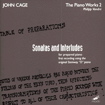
The Sonatas & Interludes, written in 1946-48, are Cage's ultimate prepared piano statement, his most-recorded music, and one of the most important piano collections of the 20th century. These 20 pieces provide an excellent introduction to his oeuvre; it's easy for Cage neophytes to focus on the sonic differences from a regular piano without getting alienated by the randomness of later works. This particular recording was made on a Steinway "O" baby grand piano, the model Cage's measurements for the preparation were made on for the placement of the screws, bolts, nuts, rubber, plastic, and eraser in the strings of the piano, it offers the best approximation of the sounds Cage had in mind while composing these pieces.
3. Atlas Eclipticalis; Concert for Piano and Orchestra: Joseph Kubera; Orchestra of the S.E.M. Ensemble/Petr Kotik (Wergo WER 6216)
Atlas Eclipticalis (1961-62), written using star maps and the I Ching and requiring improvisation, was written for 86 orchestral musicians playing conventional instruments and some percussion, but any combination of the 86 parts can be played if the available forces are smaller, and the overall time is unspecified. It was one of Cage's most notorious and misunderstood aleatoric compositions due to its premiere, when many members of the New York Philharmonic showed utter disdain for this piece that challenged the norms of the Western classical tradition. Rather than following Cage's instructions seriously, they sabotaged the intentions of the music by sarcastically inserting nursery rhyme melodies and scales and by damaging their instruments' contact mikes. Respectful performances such as the one here abjure all triviality and make a considerable impression on open-minded listeners.
4. Ryoanji; Ten; Fourteen: Ives Ensemble (Hat Art CD 6159)
Ryoanji sonically depicts the Ryoanji rock garden in Kyoto, Japan: the chance-determined, sparse percussion represents raked sand; the other instruments represent rocks, their glissando parts shaped by tracings Cage made of 15 stones (the number of rocks in the garden). The 1985 version for flute, trombone and percussion is heard here, the contrasting timbres intriguingly attractive. In Fourteen (1990)and Ten (1991), the instruments are the only fully pre-determined aspect of the music; notes and rhythms are chosen by the musicians within a system of time brackets, the duration of sounds partly determining their volume. Ten uses a microtonal system with 84 pitches in the octave. All three works are calm and meditational.
5. Sixty-Eight; Quartets I-VIII: Frankfurt Radio Symphony Orchestra/Lucas Vis (Hat Art CD 6168)
This CD offers the most meditative, settled Cage. The 1992 number/time-bracket work Sixty-Eight is built from sustained, overlapping notes. No matter how many players perform the calming Quartets I-VIII, it's structured so that only four instruments play at a time. Each sections is based on fragments of a Revolutionary-era hymn tune.
6. Piano Works, vol. 3: The Seasons; ASLSP; Cheap Imitation Stephen Drury (mode 63)
Cheap Imitation is a 1969 solo piano ballet written atop the structural skeleton of Erik Satie's Socrate, with chance operations producing new melodies. With no harmony, it's quite spare, and aptly Satie-esque. The Seasons (1947) has a recursive, mirror-like structure, with movement lengths reflecting rhythms used. ASLSP (1985) was written for a piano competition, but its chance-generated slow melodies in each hand make it atypical competition material.
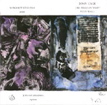 7. The Perilous Night; Four Walls: Margaret Leng Tan; Joan La Barbara (New Albion NA 037)
7. The Perilous Night; Four Walls: Margaret Leng Tan; Joan La Barbara (New Albion NA 037)
These 1944 piano works, completely notated and structured, display Cage the more conventional and emotional -- yet still distinctive -- composer. The Perilous Night is six short prepared piano pieces depicting loneliness. The lengthy Four Walls, for (regular) piano with a vocal interlude, uses silences, repetitions, and just the white keys to portray a disturbed mind.
8. Music of Changes: Herbert Henck (Wergo WER 60099-50)
Music of Changes, a 1951 solo piano work, was Cage's first I Ching-derived piece (the I Ching is also called The Book of Changes). Strictly notated, paradoxically it's random yet organized. Though it requires patience to follow, it's more immediately approachable -- and much shorter -- than the somewhat similar 1974 landmark solo piano collection Etudes Australes, constructed using a star map of the Australian sky and I Ching choices and 10 minutes shy of three hours on Grete Sultan's out-of-print classic reading.
9. Music for Merce Cunningham [Five Stone Wind; Cartridge Music]: David Tudor, Michael Pugliese, Takehisa Kosugi (mode 24)
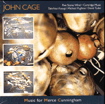 The controversial 1960 piece Cartridge Music uses contact microphones to amplify the noises of phonograph cartridges in which pipe-cleaners, wires, matches, and other objects have been inserted (not phonograph needles) and played by performers interpreting complex graphic scores, resulting in a wide variety of unusual timbres and micro-rhythms that result to be fascinating. It remains radical for how it addresses Cage's favorite theme of finding music in supposedly non-musical sounds through unbiased, open-minded listening. In Five Stone Wind (1988), Pugliese (clay drums), Kosugi (pizzicato amplified violin, "piezzo tree" for sound transducer, bamboo flute), and Tudor (electronics) use a chance-generated time-bracket score.
The controversial 1960 piece Cartridge Music uses contact microphones to amplify the noises of phonograph cartridges in which pipe-cleaners, wires, matches, and other objects have been inserted (not phonograph needles) and played by performers interpreting complex graphic scores, resulting in a wide variety of unusual timbres and micro-rhythms that result to be fascinating. It remains radical for how it addresses Cage's favorite theme of finding music in supposedly non-musical sounds through unbiased, open-minded listening. In Five Stone Wind (1988), Pugliese (clay drums), Kosugi (pizzicato amplified violin, "piezzo tree" for sound transducer, bamboo flute), and Tudor (electronics) use a chance-generated time-bracket score.
10. John Cage at Summerstage: Music for Three; 8 Whiskus; Four[6]: Joan La Barbara, William Winant, Leonard Stein, John Cage (Music & Arts 4875)
This July 23, 1992 in New York City's Central Park has Cage's final performance on the main piece here, the premiere of Four[6]. The four performers choose 12 sounds with "fixed characteristics" and deploy them within flexible time brackets, with each sound a major event. Eight Whiskus (1984) is a series of short solo songs using haiku-like "cut-up" texts (non-language use of words was an increasing interest of Cage's in his later years). Music for Three (1984) is another piece for wordless vocal sounds. 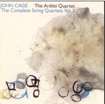 11. Complete String Quartets, Vol. 1: Thirty Pieces for String Quartet; Music for Four: Arditti Quartet (mode 17)
11. Complete String Quartets, Vol. 1: Thirty Pieces for String Quartet; Music for Four: Arditti Quartet (mode 17)
12. Complete String Quartets, Vol. 2: String Quartet in Four Parts; Four (mode 27)
In Cage's revision for the Arditti Quartet of the time-bracket piece Music for Four, the four parts are played independently and players choose note repetitions and silences in most sections. The parts are also independent The Satie-like Thirty Pieces for String Quartet (1983), 30 overlapping solos of variable length. On Volume 2, String Quartet in Four Parts (1949-50) avoids harmonic functions even when using chords, making it unpredictable and deliberately directionless, while Four (1989) is a time-bracket number pieces focusing on held notes.
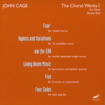 13. The Choral Works 1: Hymns and Variations for 12 amplified voices; Four²; Living Room Music; ear for Ear (Antiphonies); Four Solos; Five Vocal Group Ars Nova/Tamás Vetö (mode 71)
13. The Choral Works 1: Hymns and Variations for 12 amplified voices; Four²; Living Room Music; ear for Ear (Antiphonies); Four Solos; Five Vocal Group Ars Nova/Tamás Vetö (mode 71)
The meditative affect of Cage's music is greatly enhanced by the sustained, non-percussive sound of multiple singers, so though the works here are generally not major ones, most of them (with the exception of Living Room Music (1940), for percussion and speech quartet) are most enjoyable and accessible. The interlocking held notes of different lengths found in Four² (1990), for four-part chorus, make it an excellent example of this approach, with two realizations included here. Especially interesting is Hymns and Variations for 12 amplified voices (1979), which takes two William Billings hymns (from the 1700s) and subtracts the majority of their notes, largely eliminating any harmonic effect.
Purchase his music thru Amazon
